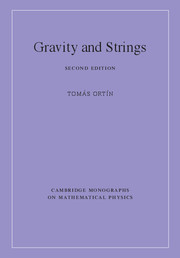Book contents
- Frontmatter
- Dedication
- Contents
- Preface to the second edition
- Preface to the first edition
- Part I Introduction to gravity and supergravity
- Part II Gravitating Point-Particles
- Part III Gravitating extended objects of string theory
- 20 String Theory
- 21 The String Effective Action And T Duality
- 22 From Eleven To Four Dimensions
- 23 The type-IIB superstring and type-II T duality
- 24 Extended objects
- 25 The extended objects of string theory
- 26 String black holes in four and five dimensions
- 27 The FGK formalism for (single, static) black holes and branes
- Appendix A Lie groups, symmetric spaces, and Yang–Mills fields
- Appendix B The irreducible, non-symmetric Riemannian spaces of special holonomy
- Appendix C Miscellanea on the symplectic group
- Appendix D Gamma matrices and spinors
- Appendix E Kähler geometry
- Appendix F Special Kähler geometry
- Appendix G Quaternionic-Kähler geometry
- Appendix H Real special geometry
- Appendix I The generic scalar manifolds of N ≥ 2, d = 4 SUEGRAs
- Appendix J Gauging isometries of non-linear σ-models
- Appendix K n-spheres
- Appendix L Palatini's identity
- Appendix M Conformal rescalings
- Appendix N Connections and curvature components
- Appendix O The harmonic operator on ℝ3 × S1
- References
- Index
23 - The type-IIB superstring and type-II T duality
from Part III - Gravitating extended objects of string theory
Published online by Cambridge University Press: 05 April 2015
- Frontmatter
- Dedication
- Contents
- Preface to the second edition
- Preface to the first edition
- Part I Introduction to gravity and supergravity
- Part II Gravitating Point-Particles
- Part III Gravitating extended objects of string theory
- 20 String Theory
- 21 The String Effective Action And T Duality
- 22 From Eleven To Four Dimensions
- 23 The type-IIB superstring and type-II T duality
- 24 Extended objects
- 25 The extended objects of string theory
- 26 String black holes in four and five dimensions
- 27 The FGK formalism for (single, static) black holes and branes
- Appendix A Lie groups, symmetric spaces, and Yang–Mills fields
- Appendix B The irreducible, non-symmetric Riemannian spaces of special holonomy
- Appendix C Miscellanea on the symplectic group
- Appendix D Gamma matrices and spinors
- Appendix E Kähler geometry
- Appendix F Special Kähler geometry
- Appendix G Quaternionic-Kähler geometry
- Appendix H Real special geometry
- Appendix I The generic scalar manifolds of N ≥ 2, d = 4 SUEGRAs
- Appendix J Gauging isometries of non-linear σ-models
- Appendix K n-spheres
- Appendix L Palatini's identity
- Appendix M Conformal rescalings
- Appendix N Connections and curvature components
- Appendix O The harmonic operator on ℝ3 × S1
- References
- Index
Summary
In Chapter 22 we initiated the study of the 11-and ten-dimensional supergravity theories which arise in the low-energy limits of the various string theories and M theory. Our goal was to study the dualities that relate the various string theories and M theory using effective field-theory actions as we did in Section 21.2 with T duality in the effective action of the common string sector. In the coming chapters we will study these dualities from the point of view of their effect on classical solutions of the effective actions that represent the classical long-range fields of perturbative and non-perturbative states of these theories, as we did in Section 21.3 with the solutions associated with string and winding modes.
In this chapter we are going to study the N = 2B, d = 10 (chiral) supergravity theory, the effective field theory of the type-IIB superstring, and how it is related to the N = 2A (nonchiral) theory after compactification on a circle (type-II T duality). Furthermore, we are also going to study the truncations to N = 1 theories, which are the effective field theories of the type-I and heterotic superstrings, finding the field-theory version of the type-I/heteroticstring duality.
First, in Section 23.1, we will study the bosonic sector of the theory, giving a non-selfdual action from which one can derive equations of motion that have to be supplemented by the self-duality constraint of the 5-form field strength [148]. We will also give the supersymmetry transformation rules to lowest order in fermions. Then, in Section 23.2 we will study the S-duality symmetry of this theory, which becomes manifest only after several redefinitions.
Next, in Section 23.3 we will perform the dimensional reduction to nine dimensions of N = 2B, d = 10 supergravity compactified on a circle. As we will see, the ninedimensional theory thus obtained is identical to the theory obtained by dimensional reduction of the N = 2A, d = 10 theory, Eq. (22.84).
- Type
- Chapter
- Information
- Gravity and Strings , pp. 688 - 702Publisher: Cambridge University PressPrint publication year: 2015



